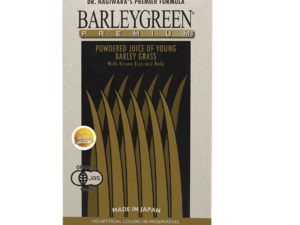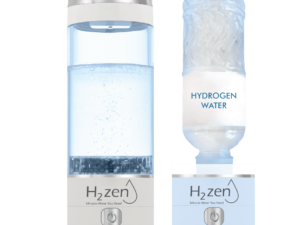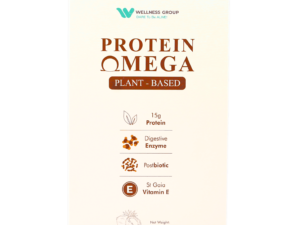Can you mix hydrogen water with juice? Benefits Explained
Surprising fact: a high‑quality SPE/PEM bottle can start losing more than 30% of its dissolved gas in under five minutes if handled roughly.
This short guide explains whether light pairings harm dissolved levels and how to enjoy flavor without losing the product’s value. It outlines simple, research‑informed rules for taste, timing, and device care.
Readers learn when to sip for best absorption (30 minutes before meals or 2–3 hours after), why they should avoid hot or carbonated drinks, and why gentle pouring matters. It notes safe add‑ins: a squeeze of lemon, thin cucumber, or mint, poured gently and consumed within minutes.
The piece also covers device basics: produce, seal, and drink soon after; use purified or distilled water to protect the PEM; and look for bottles that hit 1,500–5,000 ppb. For local help in Malaysia, Wellness Group offers guidance via WhatsApp at +60123822655 and maintains friendly business hours Monday–Friday 9:30 am–6:30 pm and weekend hours as listed.
Key Takeaways
- Light, quick pairings can be fine if consumed immediately.
- Drink on an empty stomach for optimal absorption and benefits.
- Avoid blending, boiling, or adding fats and heavy pulp.
- Use purified water and SPE/PEM bottles that show ppb levels.
- Produce, seal, and sip soon; gas levels drop over time.
- Wellness Group in Malaysia can advise on product choice via WhatsApp.
User intent at a glance: quick answer and safe starting points
Short answer for Malaysia: a small splash of clear citrus is usually fine if poured gently and consumed within a few minutes. Start on an empty stomach—about 30 minutes before meals or 2–3 hours after—for best absorption.
Practical rules: use room temperature hydrogen water and keep add-ins minimal. Avoid thick blends, oils, or hot liquids. Do not shake or blend; agitation speeds gas loss and cuts concentration.
The vessel should stay sealed until the moment of drinking. Use purified or distilled water in devices to protect membranes and preserve output. If in doubt, drink plain for the most reliable effect.
Fast-start tips for first-time users
- Mix only light, clear flavors and finish the glass within minutes.
- Stir very lightly; never shake.
- Begin with a modest amount to test how the body responds, then adjust the amount and frequency.
- Skip carbonated or hot additions that stress devices and speed gas loss.
| Goal | Best practice | Why it matters |
|---|---|---|
| Taste with minimal loss | Small lemon splash; drink within minutes | Preserves concentration and flavor |
| Device care | Use purified/distilled water; room temperature | Protects membranes and steady output |
| Absorption timing | 30 min before meals or 2–3 hrs after | Improves uptake and potential health benefits |
“For quick help in Malaysia, contact Wellness Group on WhatsApp at +60123822655 during business hours.”
The science of hydrogen water: how molecular hydrogen behaves in your glass
Tiny molecules and basic physics determine how long beneficial gas stays in a drink. Molecular hydrogen is very small and nonpolar, so it escapes quickly when the liquid is stirred, warmed, or left open. Room temperature and gentle handling slow that loss.
Why hydrogen gas escapes: volatility, time, and surface area
The main properties at play are volatility and diffusion. Agitation, heat, and a wide surface area all speed escape of dissolved gas.
Sealing the vessel and pouring gently reduce bubble formation and help keep practical levels for immediate drinking.
Absorption basics: empty stomach timing and minimal ingredients
Timing matters: sipping about 30 minutes before a meal or 2–3 hours after supports uptake in the body. Minimal, light add‑ins limit interactions that could slow intake.
What research suggests about potential health benefits and performance
Small trials report increased antioxidant enzyme activity and lower oxidative stress markers after use. Some athletic studies note reduced fatigue and modest performance gains, though outcomes vary.
“Use science to guide habits: prompt consumption and consistent routine deliver the clearest, repeatable effects.”
- Keep it sealed until serving to preserve levels.
- Avoid heat, vigorous shaking, and long wait times.
- Simple, prompt use aligns best with current research findings.
Can you mix hydrogen water with juice?
Short answer: a small, clear splash of citrus is usually fine if the glass is handled gently and finished fast.
Best practice: a splash of lemon versus heavy blends
Lemon juice or thin cucumber slices add flavor without heavy solids. Thick, pulpy blends or creamy smoothies introduce fibers and fats that slow sipping and force off gas.
How much and how fast
Keep the amount tiny—about a teaspoon to a tablespoon per glass. Add the flavoring first, then gently pour the drink over it.
Stir once or twice and drink within a few minutes. Time and gentle handling preserve useful concentration and the likely benefits.
- Room-temperature servings reduce thermal loss.
- Swap in mint or cucumber for a mild lift if citrus is too strong.
- If unsure, plain water may be best for consistent results.
| Choice | Why | Quick tip |
|---|---|---|
| Clear citrus | Adds brightness with minimal solids | Use 1 tsp, pour gently |
| Cucumber or mint | Neutral, low impact on gas | Slice thin, drink fast |
| Pulp/creams | Reduce gas and slow intake | Avoid for best results |
“Add flavor first, pour gently, and finish promptly for the best outcome.”
How to mix hydrogen water with juice the right way (step-by-step)
A careful order and calm hands preserve concentration and deliver a pleasant sip.
Choose the juice: pick clear, low‑pulp options at room temperature. Lemon is popular because it brightens taste without heavy solids.
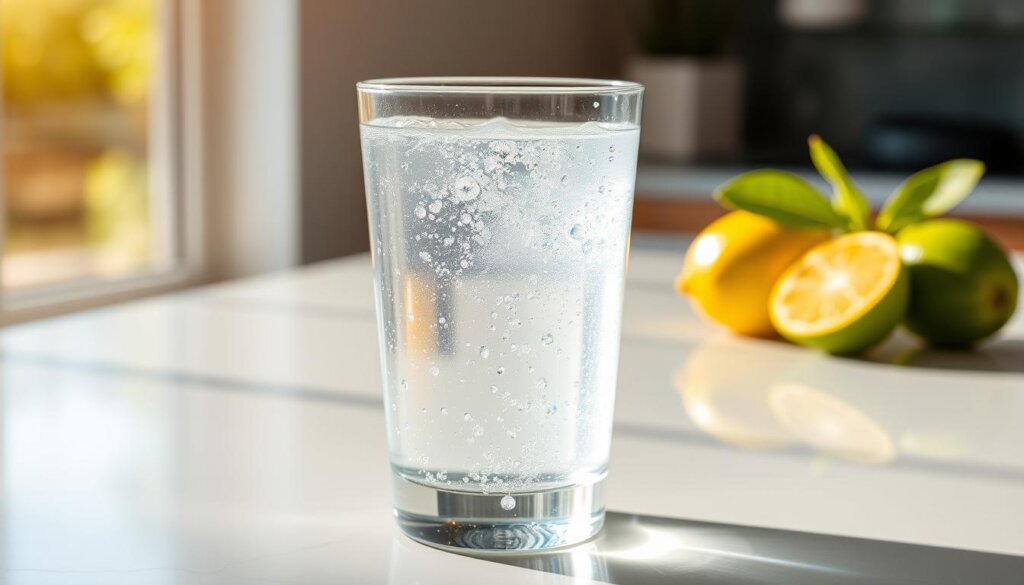
Sequence and handling
Add the flavoring first, then gently pour the hydrogen water over it. Measure the amount water by eye: add the syrupy or citrus element, then top up slowly to avoid turbulence.
Do’s for maximum hydrogen
- Stir once or twice only; do not shake.
- Drink within a few minutes so gas loss stays minimal.
- Keep servings small so finishing the glass is easy.
Sample mini‑recipes
- Lemon Lift: juice of 1/4 lemon, add 1 cup hydrogen water, stir once, sip immediately.
- Cucumber‑Lime Twist: two thin slices, tiny lime squeeze, pour, wait 1–2 minutes, finish promptly.
- Mint‑Citrus: lightly muddle two mint leaves, add a few drops of lemon juice, pour, brief stir, drink right away.
| Step | Action | Why it matters |
|---|---|---|
| Choose | Clear, low‑pulp flavor at room temperature | Limits solids that trap gas |
| Sequence | Flavor first, pour gently over | Reduces turbulence and loss |
| Finish fast | Drink within minutes and cap between sips | Preserves useful levels for best effect |
“Add flavor first, pour slowly, and finish within minutes for the best outcome.”
What not to do: common mistakes that reduce hydrogen concentration
A few common habits undo the work of good devices and cut hydrogen levels in minutes. These errors lower concentration and reduce potential health benefits.
Avoid hot liquids, fats, and thick blends
Never pour the drink into a hot cup or boil it. Heat speeds escape and can harm delicate device parts.
Avoid thick smoothies, dairy, and oily add‑ins. Fats and proteins slow sipping and leave the glass exposed for too long.
Skip agitation, carbonation, and long waits
Vigorous shaking or blending adds bubbles that strip hydrogen gas from solution. Carbonated sodas force fast gas exchange and damage components.
Do not let the glass sit out. Finish servings promptly; do not leave the water long on the counter.
Protect the device and follow simple habits
Keep generator bases dry and never submerge them. Overfilling and prolonged stirring increase surface area and speed loss.
Think of dissolved gas as volatile: gentle handling and quick drinking keep more of the benefit.
- Quick tip: choose small citrus or herbs for flavor without heavy agitation.
- Device care: avoid sugary sodas in generators to protect membranes and maintain output.
Quality matters: bottles, ppb targets, PEM/SPE tech, and water choice
Start with the right kit. A reliable hydrogen water bottle makes the biggest difference in results. Pick devices built on SPE/PEM technology and check manufacturer ppb claims before buying.
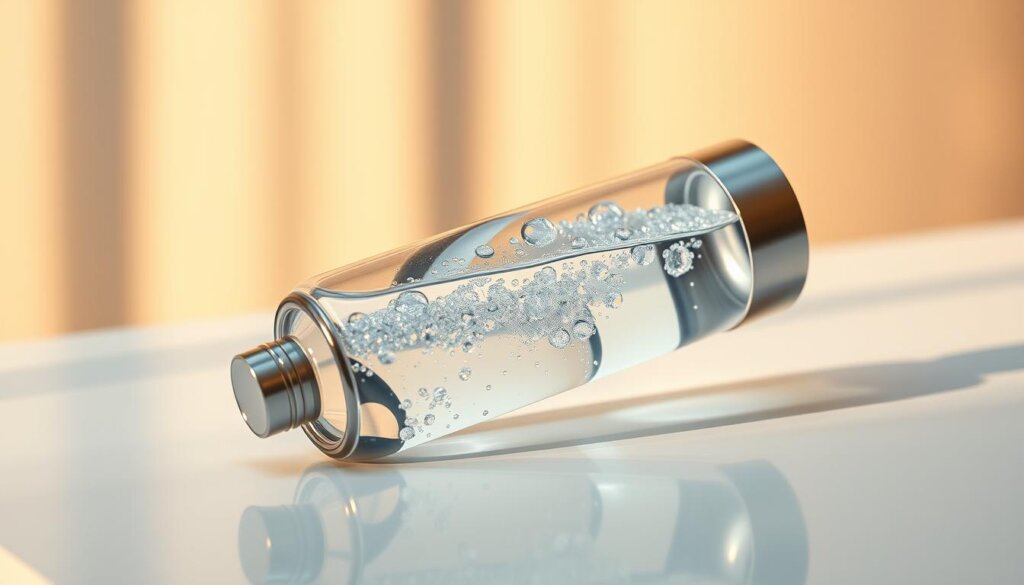
What to look for in a device
Choose a hydrogen water bottle that uses SPE or PEM. Good models reach at least 1,500 ppb, while premium options hit 3,000–5,000 ppb. Durable, BPA‑free materials and a 200–300 ml size suit daily use in Malaysia.
Water input and why it matters
Prefer purified or distilled water to reduce minerals and metals that foul the pem. Tap water works short term, but minerals lower device lifespan and steady output.
Usage and care rules
- Room temperature inputs and sealed lids preserve dissolved gas and safe operation.
- Leave a small amount of water in the base to keep the pem moist; never submerge or flush the base.
- Descale with a 1:1 white vinegar cycle, then run plain water to rinse.
- Avoid hot liquids above 60°C, don’t operate while charging, and limit back‑to‑back cycles.
Tablets and travel options
Hydrogen tablets offer portable convenience. They are a useful alternative when a bottle is impractical, but users should dissolve them and drink within minutes to retain useful levels.
Practical rule: match a quality device, good input water, and simple habits for the best hydrogen experience.
Malaysia-ready routine: simple daily plan and support from Wellness Group
A simple plan makes it easy to use hydrogen products reliably each morning and afternoon.
Suggested schedule: have one serving about 30 minutes before breakfast and a second mid‑afternoon, roughly 2–3 hours after lunch. Keep each serving small so the body gets it quickly and the glass is finished in a few minutes.
Use purified or distilled water for devices, keep lids sealed during operation, and avoid hot or carbonated liquids. Follow device rules so each session gives consistent results and protects the product.
Quick practical tips
- Small servings and prompt drinking preserve concentration and likely benefits.
- For training, a pre‑workout serving may support perceived performance and recovery.
- Track feelings for a week—note energy, focus, or post‑exercise comfort to personalize timing.
| Routine | Why it helps | Quick action |
|---|---|---|
| 30 min before meals | Better uptake in the body | Drink on an emptystomach |
| 2–3 hrs after meals | Reduced interaction with food | Keep servings small |
| Device care | Longer product life and steady output | Use distilled water; seal lids |
“Consistency over weeks tends to reveal the clearest results.”
Need help in Malaysia? WhatsApp Wellness Group at +60123822655. Business hours: Monday–Friday 9:30 am–6:30 pm; Saturday–Sunday 10 am–5 pm.
Conclusion
, Final takeaway: small servings, gentle handling, and quality tech yield the most reliable effects for daily use.
Simple habits—timing on an empty stomach, tiny add‑ins, and drinking fast—keep concentration and help deliver potential health benefits. Pair that routine with SPE/PEM technology and aim for devices that report at least 1,500 ppb.
Use purified or distilled inputs to protect the pem, avoid hot liquids, and schedule routine vinegar descaling to limit minerals and metals buildup. Tablets work well for travel but follow the same quick‑drink rule.
For product advice and local support in Malaysia, contact Wellness Group via WhatsApp at hydrogen water while pregnant or +60123822655 during business hours.
FAQ
Can a person mix hydrogen water with juice safely?
Yes, they may combine a small amount of clear, low-pulp juice with hydrogen-rich water. A light splash of lemon or lime is least likely to force gas loss and keeps taste pleasant. Heavy, pulpy, fatty or protein-rich additions reduce dissolved gas and should be avoided.
What is the quick guidance for users in Malaysia about mixing?
For Malaysia, the short guidance: add only mild, low-acidity juices and drink immediately at room temperature. Avoid hot liquids and thick smoothies. This preserves dissolved molecular hydrogen and maximizes any potential benefits.
What fast-start tips help first-time users get the best results?
Start simple: use purified or distilled water, pick a clear citrus like lemon, pour the juice first, then gently add hydrogen water. Drink within minutes and avoid shaking or vigorous stirring. Keep servings small to limit hydrogen loss.
Why does molecular hydrogen escape from water so quickly?
Hydrogen gas is highly volatile and diffuses rapidly. Larger surface area, higher temperature, and agitation speed its escape. Time is the main enemy—dissolved hydrogen concentration drops noticeably within minutes if exposed to air or stirred hard.
When is absorption of dissolved hydrogen best?
Absorption tends to be most efficient on an empty stomach or with minimal other ingredients. Small, plain doses taken 20–30 minutes before a meal or a couple hours after eating help reduce interference from foods or fats.
What does research suggest about potential health benefits and performance?
Emerging studies indicate possible antioxidant and anti-inflammatory effects and modest support for reduced muscle fatigue in some users. Evidence is preliminary; benefits vary by dose, concentration, and individual factors. More large trials are needed.
Is a splash of lemon juice better than a pulpy blend?
Yes. A splash of lemon or lime is best practice because it minimally disturbs dissolved gas and adds flavor without introducing solids or fats that drive hydrogen off the liquid.
How much juice should someone add and how fast should they drink it?
Keep additions small—one to two teaspoons per 250–350 ml of hydrogen water. Stir very lightly or not at all and drink immediately, ideally within a few minutes after mixing to retain most of the dissolved gas.
What types of juice work best for mixing?
Clear, low-pulp options such as fresh lemon, lime, or lightly strained cucumber juice work best. These maintain dissolved gas and offer fresh flavor without thick particulates.
What sequence preserves the most dissolved hydrogen?
Add the juice to the glass or bottle first. Then gently pour hydrogen-rich water over it to minimize agitation and reduce surface disturbance that causes rapid gas loss.
What practical do’s help keep maximum hydrogen in the drink?
Do use room-temperature water, avoid shaking, keep lid sealed, drink within minutes, and choose low-pulp juices. Small servings and minimal stirring preserve concentration.
Are there simple mini-recipes that work well?
Yes. Examples: lemon lift (a few drops of lemon), cucumber-lime twist (strained cucumber plus lime), or mint-citrus (light mint muddle with a splash of orange extract). All should be low-pulp and consumed immediately.
What common mistakes reduce hydrogen concentration?
Avoid adding fats, dairy, proteins, or thick smoothie ingredients. Do not use hot liquids or boil. Vigorous blending or shaking and long delays between production and drinking markedly reduce dissolved gas.
Why should carbonation and vigorous blending be avoided?
Both processes increase agitation and release dissolved gases. Carbonation also alters solubility dynamics and can displace hydrogen, lowering ppb levels rapidly.
What should buyers look for in hydrogen water bottles and tech?
Choose bottles using solid polymer electrolyte (SPE/PEM) electrolysis and aim for reliable ppb output. Models that advertise stable concentration and have clear maintenance guidance are preferable.
Is purified or distilled water better than tap for devices?
Purified or distilled water helps protect membranes and electrodes in PEM/SPE devices. It reduces mineral buildup, extends device life, and supports consistent hydrogen production compared with hard tap water.
What are the ideal usage rules for bottles and storage?
Use at room temperature, keep lids sealed, drink soon after production, and avoid submerging the electronic base. Regularly clean according to manufacturer instructions to maintain performance.
How should a user care for PEM-based bottles?
Keep the membrane moist per instructions, avoid hot water cleaning, descale with recommended solutions, and never immerse the base. Proper care preserves ppb output and device longevity.
How do hydrogen tablets and other methods compare?
Tablets are convenient but timing matters: dissolve fully in cool water and drink immediately. PEM/SPE bottles offer continuous production and control of concentration but require maintenance. Each method has trade-offs in cost, convenience, and peak ppb.
What schedule suits a Malaysia-ready routine for daily use?
A simple plan: take a small dose about 30 minutes before main meals or 2–3 hours after eating. This fits local meal patterns and helps avoid interference from heavy foods.
How can someone contact Wellness Group for advice in Malaysia?
Users may reach Wellness Group via WhatsApp at +60123822655 for product guidance, scheduling, and local support during listed business hours.
What are Wellness Group’s business hours for contact?
Business hours are Monday–Friday 9:30 am–6:30 pm, and Saturday–Sunday 10:00 am–5:00 pm. Response times may vary outside these times.

Khloe Tan
Khloe Tan is a Certified Nutritionist, Corporate Wellness Trainer, and Holistic Health Specialist with over 15 years of experience in the health and wellness industry. She has delivered more than 100 talks nationwide, inspiring and educating diverse audiences on nutrition, lifestyle, and sustainable wellness. Her work has positively impacted over 3,000 lives, and she continues to champion holistic approaches to well-being in both corporate and personal settings.
Feature Product
-
Hydrogen Water FIlter/Generator
H2zen Portable (White/ Blue)
RM2,600.00 Add to cart Buy NowRated 0 out of 5

